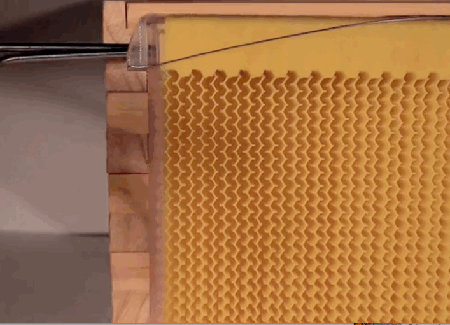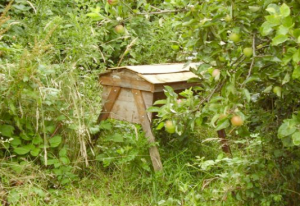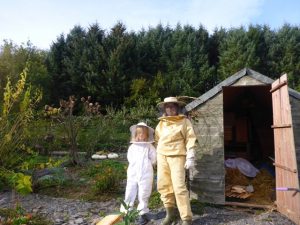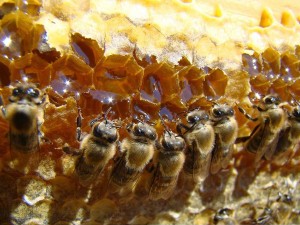Flow Hive honey tap set to revolutionise beekeeping worldwide…. what’s wrong with that?

Stu Anderson lives at the end of a steep and stony track not far from Byron Bay in Northern New South Wales. His beautiful, hand-made home stands amongst others, surrounded by lush rainforest. Stu is one half of the father son team behind the Flow™Hive. It’s an invention which has captured the imagination of the beekeeping community worldwide by creating a way to “tap” honey directly without the need to open the hive. Their crowd fund campaign took less than 8 minutes to reach their $70,000 target and went on to smash records, raising over US$12m. But the Flow™Hive has attracted strong criticism from natural beekeepers. In this article, we’ll hear from the inventors themselves and also from Adrian Iodice, a natural beekeeper with a small business homestead in the Bega Valley in Southern New South Wales.
When I first meet Stu, over a year before the launch of Flow™Hive, it is to record an interview for a documentary I am making about community. Tall and tanned, his gently greying hair curving around the collar of a cotton shirt, he greets me warmly before walking me down the quiet, narrow road through his community. On the way, we stop and speak with Cedar, Stu’s son, who has his head under the bonnet of a broken-down truck. It’s clear that father and son both share a skill for mechanics. Stu is the engineer of many technical innovations in the village, such as the off-grid electricity fed to all the homes. What I don’t realise at this time, is that the Anderson family has nurtured three generations of keen bee-keepers, and that these two are about to launch an innovation which may well revolutionise the world of beekeeping. Instead of having to open the hive to collect honey, their Flow™Hive incorporates a specially designed frame of comb. Embedded with a split cell system which releases the honey from the comb, the beekeeper can simply insert a tap and the honey flows out. Easy!
But some natural beekeepers protest that the Flow™Hive does not have the bees’ interest at heart. To understand their objections, it helps to have a broad picture of beekeeping practice.
Though inevitably a form of husbandry, beekeeping around the world exists on a continuum. Commercial honey producers, on one end, are often criticised for their over-intervention in hives – such as treating bees with antibiotics and anti-fungals which pollute the honey. Environmental beekeepers, on the other end of the spectrum, place little importance on honey-gathering. They “rob” the hive only when the honey is in excess, and then often only for medicinal purposes. Natural bee keepers seem to exist somewhere along this continuum. They extract honey, but they also place bee and colony health at the forefront of their practice.

Over 50% of all honey is currently produced in China. Their operations involve on average about 50 colonies of bees, whilst in Canada, it’s more like 1000. It’s likely all these beekeepers use a hive design dating back to 1852, when Lorenzo Langstroth invented removable frames, enabling honey to be taken without destroying the whole colony. The Flow™Hive, whilst working with the Langstroth hive design, claims a new level of bee care – the removal of honey without disturbing the bees at all. With bee health on the global agenda following widespread loss of colonies, this particular invention seems to be capturing the zeitgeist.
One of first to disagree that the Flow™Hive would be good for bees was Milkwood, a social enterprise working with natural beekeepers alongside permaculture teachers, farmers and natural builders on courses in and around Sydney. Milkwood representative Kirsten Bradley expressed nothing short of horror at both the mechanism and philosophy of the new invention, comparing it to powdered potato and battery chickens. Another post, on the Natural Beekeeping Trust website, compared the Flow™Hive to a cyborg, because of its replacement of hive “body” parts with mechanical elements.
Adrian Iodice, from Beekeeping Naturally, is equally disturbed. I speak to him as he heads back to his young family after five days on the road. He’s tired, and his voice is passionate, if weary.
“People have no idea about bees and honey and they’re so excited about this bee hive. They don’t really understand the complex society of a Bee organism. They don’t know the plight of bees. At a time when Bees are dying in their billions around the world, the last thing we should be focusing on is the honey. I feel it’s just another nail in the bloody coffin.”
The capitalisation of the word “Bee” refers to the colony, rather than the single bee, and it’s a distinction which refers to the holistic nature of the colony and the way bees together behave as one being. It implies a spiritual, even mystical relationship which has long intrigued the beekeeper.
Adrian argues that the Langstroth hive itself is part of the problem, because the design of it means that you have to rip the roof off to do an inspection. “ A better hive”, says Adrian, “ is the Kenyan Top-bar hive where most of the heat and nest scent is maintained during inspections and honey harvesting. It also keeps the brood chamber whole, which is seen by natural beekeepers as the “heart’ of the colony. I find that with this hive, the Bees are happier and much easier to work with!”
Speaking from his home near Byron Bay, Stu reminds me that the response to the Flow™Hive has been overwhelmingly positive, but says that they do welcome people thinking carefully about what they have to offer. One of the main criticisms has been that the Flow™Hive may cause inexperienced bee keepers to over-tap the hive, thus leaving the bees starving. Honey ‘robbing’ is so-called because it is the bees’ food, and Adrian argues that it shouldn’t be the main focus of keeping a hive.
“The whole emphasis in bee-keeping these days, even at a back-yard level, is on “how much honey do you get? We keep the bees working to fill the void left when we take the honey. We stress them out!”
“One of the things we’ve been trying the emphasise all along”, responds Stu, “is that really looking after these bees involves learning a lot, and observing a lot, and spending time with them. All that’s changed is that you don’t have to spend as much time disturbing the bees and as much time in your sticky laundry! In theory, our invention gives beekeepers more time to spend with their bees. Grab a cup of tea or a beer and sit outside the entrance of their hive and just watch. You’ll learn a lot.”
Adrian feels that it’s just too tempting when it’s made so easy.
“Even though the inventors of the FLOW hive advocate responsible management and care, the common perception out there is that ‘All you have to do is turn on the tap and collect the honey’. Honey harvesting is 1 or 2 days work out of a whole season of caring for your Bees, Its the reward we get if there is surplus honey for us to take, there is so much more to it than just taking the honey.”

Stu is clearly aware of the conversations his invention has initiated.
“Some of the criticisms have been that our invention leads to more potential for industrialisation of beekeeping and we don’t think the invention makes any difference either way. Beekeeping has already been industrialised. Our invention means that if people are using industrial techniques, bees won’t get stressed as much, but they’re already using techniques that at times can be pretty brutal.”
Adrian doesn’t feel it’s an excuse that “it’s already happening”. He speaks particularly vehemently about the use of plastic in the Flow™Hive.
“The end product is having a heap of bees living in plastic and making that ok. And that’s not ok. It’s not ok to have bees living in plastic that off-gases. Because no matter what kind of food-grade plastic they use, they know that it’s going to off-gas. We’re talking about the bees. Where they live. Their home. And when you’ve got a hive. Heating up, cooling down, humidity. That is going to off-gas. Just that in itself, in my eyes, should be illegal.”
“If we could do this with some sort of natural materials, we would, and we’ll keep working on that. But right now, we couldn’t see any other alternative. The bees do cover the plastic matrix in wax, and they ventilate their hive constantly. Plastic frames have been used in beehives for 20 years without any known problems. Nevertheless, we look forward to using a more ‘natural’ material in the future.” says Stu.
Being that Stu himself has chosen to live in a natural home, I can see the problem with inviting bees to live in a synthetic pre-fab, and Adrian agrees.
“These bees are lucky if they make the next twenty years and that’s a fact because of all the poisons we’re putting on our planet. And now we’re going to subject them to tens of thousands of plastic hives. All these bees in these plastic colonies. Just that in itself is enough for me to be really upset.”
Some of the effects of the Flow™Hive we may never be able to quantify, but at present, Team Flow seems to be managing the dramatic shift from pitching a crowd-fund to operating a functioning business. Their initial deliveries have been ahead of time and their websites promises education and information about bee-keeping. Their community forum provides a space where Flow-users can discuss their experiences. Stu feels that the Flow™Hive has the potential to empower a lot more people to keep bees. “Beekeeping is such heavy work if you do it traditionally.” he says. “Our invention has made it more available to women and people who are older and so on…So more people will be keeping more bees.”
Adrian is ambivalent about the attention now focussed on bees because of the Flow™Hive. “I’m happy it’s going to get people interested in bees, but is it the right way to get people interested in bees?”
Much of this discussion is about fundamental principles, such as the emphasis on honey and the design of the Langstroth hive on which the Flow™ frames are based, so in some ways, the a two sides appear to have reached an impasse. Maybe it’s up to us, as new or established beekeepers, to educate ourselves and make our own decisions about how, why and whether we keep bees at all.
Author Bio: Helen iles is a Welsh independent film-maker/writer currently living in Melbourne. Her film exploring intentional communities in Australia is screening at IPPC London in September, Transitions Film Festival Totnes in November and is available until
October 1st via a crowd fund campaign :
The views expressed in our blog are those of the author and not necessarily lowimpact.org's
6 Comments
-
1Michael Bush August 24th, 2015
When I first saw the video of the Flow hive I thought of this story from “Mastering the Art of Beekeeping” by Ormond and Harry Aebi:
” ‘I want to buy one of your beehives’ he said. ‘I want you to bring it to me tomorrow at eleven in the morning and I want you to set it up on top of a ten foot pole that I’ll have set up by that time. And I want you to come over every Thursday afternoon and drain out the honey so that I can have fresh honey every week.’… ‘I can’t place a beehive up on a pole like that,’ I said. ‘And even if I could, I couldn’t work it to take off the honey.’ ‘Why not? I shall expect you to install a spigot at the bottom of the hive. All you’ll have to do is open it and drain off the quantity of honey I require.’ ‘Beehives don’t work that way,’ I told him. ‘I can’t possibly do as you ask.’…”
> It’s likely all these beekeepers use a hive design dating back to 1852, when Lorenzo Langstroth invented removable frames,
It is commonly said that Langstroth did, but of course, Huber invented a moveable frame hive in 1789 and Dzierzon invented it in 1838 and Berlepsch invented it between 1838 and 1852. So Lorenzo Langstroth was probably the LAST person to invent movable frame hives, bringing to mind the old quote by James Joyce: “Christopher Columbus, as everyone knows, is honoured by posterity because he was the last to discover America”
But that’s not really the topic…
>Milkwood representative Kirsten Bradley expressed nothing short of horror at both the mechanism and philosophy of the new invention, comparing it to powdered potato and battery chickens. Another post, on the Natural Beekeeping Trust website, compared the Flow™Hive to a cyborg, because of its replacement of hive “body” parts with mechanical elements.
I’ve found these comparisons odd considering that battery chickens are held captive in a little cage which they can’t leave and can only stand up, sit down, eat, poop and lay eggs. While bees in a Flow hive are no different than bees in any other hive, coming and going as they please and living out their lives with the same instincts they have always had and free to leave anytime they like. Powdered potatoes are not animals and are just a very unappetizing way to prepare potatoes. I simply don’t see any valid comparison. As far as “with mechanical elements” that’s what movable frames are… and those are required by law almost the world over.
>”People have no idea about bees and honey and they’re so excited about this bee hive. They don’t really understand the complex society of a Bee organism. They don’t know the plight of bees. At a time when Bees are dying in their billions around the world, the last thing we should be focusing on is the honey…”
Yes but honey is reason humans took an interest in the first place and once people have a hive in the back yard they will learn a lot about bees and their complex society.
>Adrian argues that the Langstroth hive itself is part of the problem, because the design of it means that you have to rip the roof off to do an inspection. ” A better hive”, says Adrian, ” is the Kenyan Top-bar hive where most of the heat and nest scent is maintained during inspections and honey harvesting.
This is beekeeping. I would guess that 9 out of 10 Langstroth users think that a top bar hive is unnatural because it’s horizontal rather than vertical… Ask 10 beekeepers something and you’ll get 12 different opinions.
>One of the main criticisms has been that the Flow™Hive may cause inexperienced bee keepers to over-tap the hive, thus leaving the bees starving.
The same criticism was made of the Langstroth when it came out. You still have to learn to keep bees and you have to learn to leave them enough. When the Langstroth hive came out it was suddenly easy to get every last comb of honey. This was not so easy with a box hive or a skep so it wasn’t so much of a problem. Beekeepers had to adapt their management for the new equipment.
>Adrian feels that it’s just too tempting when it’s made so easy.
He’s just talking about harvesting honey, but I’ve also heard this argument for why the Flow hive is evil. Because it will bring in people who shouldn’t be beekeepers because it’s too easy. I don’t understand the “too easy” argument. I see where people are coming from, though. I’m quite sure when the US pioneers first went west they were a different kind of people. The hardships filtered out a lot of people and the ones that went west had a different level of commitment and determination. I’m sure when the transcontinental railroad went through and people could hop a train and be there in a day or two instead of months of preparation and months of walking with everything they owned with them, they were not the same kind of people. And I’m sure the old settlers were dismayed at the overall quality of people coming to a place they worked so hard to get to. But that’s not going to stop us from building railroads. Just because my grandmother washed cloths by had with a washboard does not mean I’m not going to buy a washing machine…
>Adrian doesn’t feel it’s an excuse that “it’s already happening”. He speaks particularly vehemently about the use of plastic in the Flow™Hive.
>Stu: Plastic frames have been used in beehives for 20 years without any known problems.
I think Stu’s point is that people will do what they will do. The Flow hive is not the cause of that. As far as plastic, we live in a world full of plastic. I’d love to avoid it. If you can’t stand plastic, then don’t buy a Flow hive. I think Stu was quite conservative in his estimate. I’ve had plastic foundation for 40 years… let’s face it people have been using plastic foundation now for probably a century. It was pretty common a half century ago. People have been using fully drawn plastic comb (not just foundation) since at least half a century ago. I remember ads for it in the bee journals in at least 1974. This is not new and not limited to the Flow hive. If plastic bothers you, then don’t use it. No one is forcing you.
>And now we’re going to subject them to tens of thousands of plastic hives. All these bees in these plastic colonies. Just that in itself is enough for me to be really upset.”
Not “now”. We started doing it a century ago…
-
2Dave Darby August 24th, 2015
Michael, your understanding of bees is phenomenal, but mightn’t the fact that ‘people have been using plastic foundation now for probably a century’ have something to do with the fact that bees are in so much trouble now? Plus saying ‘If plastic bothers you, then don’t use it. No one is forcing you.’ is analogous to saying ‘if DDT bothers you, then don’t use it. No one is forcing you.’ If what you’re doing is damaging to nature, to bees, to other people, maybe you shouldn’t get to choose whether you do it or not?
-
3Heidi Herrmann August 24th, 2015
We have, at the Natural Beekeeping Trust, commented extensively on the so-called flow hive. What an extraordinary phenomenon it is!
To briefly comment on the above: What stands in dire need of “revolutionising” is our collective way of thinking and feeling about the bees; the mere idea of the flowhive and its subtle appeal to our voracious consumerist outlook vis-a-vis the bees would gain no entry WHATSOEVER into such renewed ways of thinking.
What is more, if we really revolutionised our thinking with regard to nature, the shallow pretension that such a device could in any way be helpful to the bees (by allegedly disturbing them less, by even offering a “new level of bee care” etc.) would appear in its full light (or dark, one should probably say).
The enthusiastic response to the flow hive is a very apt reflection of the shallow and lazy ways of thinking extant today. No living creature of this earth, let alone this earth, will ever be helped by attitudes or practices that are not fully grounded in an ethical and moral approach to the living world.
-
4Kirsten Bradley September 25th, 2015
Hello! Yes there’s mis-understandings all over the place around this tech (actually, the flow technology is a new type of plastic *frame* that fits into a langstroth hive, not a new hive technology, itself) – just to clarify with the powdered potato reference + battery chickens, if anyone wanted to take the time to read my article what I actually said was:
– the flow hive is marketed as being super easy and absolutely no work, and so to has powdered potato been marketed. This line of marketing speak doesn’t actually mean that easy equals good, either in the case of bee health (flow), or human health (powdered potato).
– I compared battery chickens as a form of industrialised animal husbandry to be coming from the same point of view as large scale industrial langstroth beekeeping – ie, the assumption that if the animal/insect still manages to produce an output, despite their non-ideal living conditions, they must therefore be healthy and happy. This is not so with chickens, and neither so is it with bees, there’s plenty of evidence around of that.
At the end of it all, I really just see the flow frame as another plastic do-hickey for langstroth hives, that’s been marketed as an easy, healthy, natural and wonderful bee-centric invention. Which I don’t think it is.
If we are to keep backyard bees (which is what this flow tech is clearly aimed at), I think we should aim to keep them in a bee-centric way using natural beekeeping principles: natural reproduction, bee-made natural comb, queen roams free, appropriate hive design, low intervention, good stewardship, harvesting only surplus honey. Beekeeping is amazing. There’s no need to overcomplicate it.
-
5chrisjsuk September 28th, 2015
As a beekeeper of the last 46 years I can tell you I wont be using the flow hive. I predict it will be bought by numbers of beekeepers, used for a short time and then abandoned. Bees dont act like predictable units in a machine. They put pollen in the ‘wrong’ place, produce honey the instantly crystallises in the comb, escape through the queen excluder and lay in their honey supers to name but a few behaviours My collection of hive parts have seen many years of use and should be useful for many more – they are not easily adaptable to Flow hive technology..
-
6DiHammill October 5th, 2015
Beautiful Words Heidi. I have just started to follow the Natural Beekeeping Trust having done a traditional course last year and been horrified. Lots of people have asked me what i thought about this new hive and I so far have replied I don’t know enough but it doesn’t feel right, thank you all for this article and the subsequent comments for helping me form a better picture. Di Hammill of Wild Harvest Rural Crafts.




 Natural beekeeping: should it replace conventional beekeeping?
Natural beekeeping: should it replace conventional beekeeping?
 Build your own top bar beehive
Build your own top bar beehive
 Is ‘beekeeping’ actually ‘hive robbery’?
Is ‘beekeeping’ actually ‘hive robbery’?
 Beekeeping
Beekeeping


